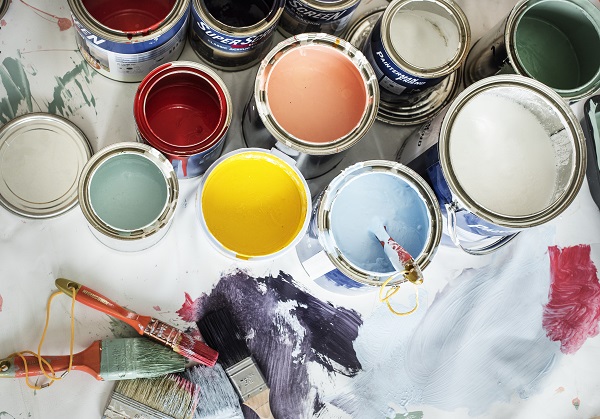
What is emulsion paint?
Professionals and do-it-yourselfers alike like to use emulsion paint when it comes to painting indoor and outdoor walls. But what are the components of the product? As the name already suggests, wall paint consists of dispersion – a heterogeneous mixture of two substances. Emulsion paint is mostly an emulsion, i.e. a mixture of two liquids that normally do not mix.
The composition of the paint consists of binders and solvents, pigments as well as fillers, and additives. In white color, for example, titanium dioxide is predominantly contained. Emulsion paint is water-based and used to be called binder paint. In hardware stores, it is often sold as interior paint or interior wall paint.
There are two different types of emulsion paint: synthetic resin paints and natural resin paints. The latter is mainly based on linseed oil or castor oil. Synthetic resin emulsion paint, on the other hand, consists of water and synthetic resin. The resin is obtained from mineral oil or plastic. Both types of paint can contain preservatives, while the synthetic resin variant can also contain solvents. Both types of paint are also available without preservatives and solvents.
Differences from other wall colors
In addition to emulsion paint, there are other wall paints. The most common are latex paints and mineral paints. The latter type of paint includes lime paints, cement paints, and silicate paints. Like emulsion paints, latex paints are made of synthetic resin, but have a more stable surface and are therefore more durable. Polyvinyl acetate is mostly used as a binder, as with emulsion paints. However, latex paints have a higher proportion of binder. This type of paint is particularly suitable for rooms whose walls are subject to heavy wear and need to be cleaned regularly – for example, bathrooms, kitchens, hallways, and stairwells. As with emulsion paint, the rooms must be well-ventilated, as both paints are not open to diffusion, and thus the risk of mold increases.
Silicate paint
is mainly suitable for living rooms and bedrooms because it is stable and hard-wearing. In contrast to emulsion paint, silicate paint combines with the underground. In this case, one speaks of the silicification of the paint. The wall paint uses potassium water glass as a binder, which makes the paint inorganic. In contrast to dispersion, silicate paint is not available in all shades. In addition, silicate paint is not suitable for hobby craftsmen, since the amount of work is quite high. While you can process emulsion paint directly, you have to mix two-component silicate paint. You should also wear protective equipment when painting, as silicate paint has high alkalinity and is caustic when wet. The wall paint is open to diffusion and thus regulates the room humidity. In addition, it contains neither solvents nor preservatives.
Before the emulsion paint came the distemper was the first choice for wall painting. However, this is only smudge-proof and not wash-proof and cannot be painted over as easily as dispersion. It is also easier to use than distemper paint.
What is emulsion paint used for?
It can be used in many ways. You can use it to paint walls indoors and paint facades outdoors. Because of its properties, it is the first choice for non-mineral substrates. If you want to paint a mineral substrate, you should first apply a primer. Since emulsion paint is healthy for living, you can use it to paint all rooms in the house.
Pros and cons of emulsion paint
Emulsion paint owes its popularity to its many positive properties. One of these advantages is that the wall paint dries very quickly. The painted surface is already dry after four hours. That is why interior paint is so popular for renovations and is also used for painting ceilings. Furthermore, the product is odorless and can be wiped clean with a damp cloth. The wet abrasion class on the paint bucket indicates how scrub-resistant the paint is. Class 1 offers the highest abrasion resistance and class 5 is the lowest. Emulsion paint can also be diluted with water and is suitable for almost all surfaces from plaster walls to wallpaper and plaster.
In addition, emulsion paint is stain-resistant and offers high coverage. As a rule, you only need one coat for an adequate result. The manufacturers indicate how high the opacity is on the paint cans. As with the wet abrasion class, class 1 indicates a very high opacity – interior paint has the worst opacity with class 4.
Another advantage of emulsion paint is the price-performance ratio. Usually, the wall color is particularly cheap. When buying, pay attention to high opacity and wet abrasion class. It is also available in countless shades, but can also be mixed to your desired color with tinting paint. You add pigments to white emulsion paint.
The wall and facade color also has disadvantages. Unlike silicate paint, it does not regulate this room’s climate because it is not open to diffusion. This makes the paint susceptible to mold. Depending on the manufacturer, emulsion paints also contain preservatives and solvents.
How productive is emulsion paint?
When buying wall paint, in addition to opacity and wet abrasion, yield plays a major role. Manufacturers normally indicate how many square meters a bucket of paint is sufficient for. However, this specification of the yield always only refers to one coat, but sometimes the result is not satisfactory and you have to paint another coat. It is better to buy a little more paint than you need for one coat.
Send us your inquiries and we will be in contact shortly.
Follow us on:
Facebook | Instagram | Twitter | LinkedIn | Google My Business